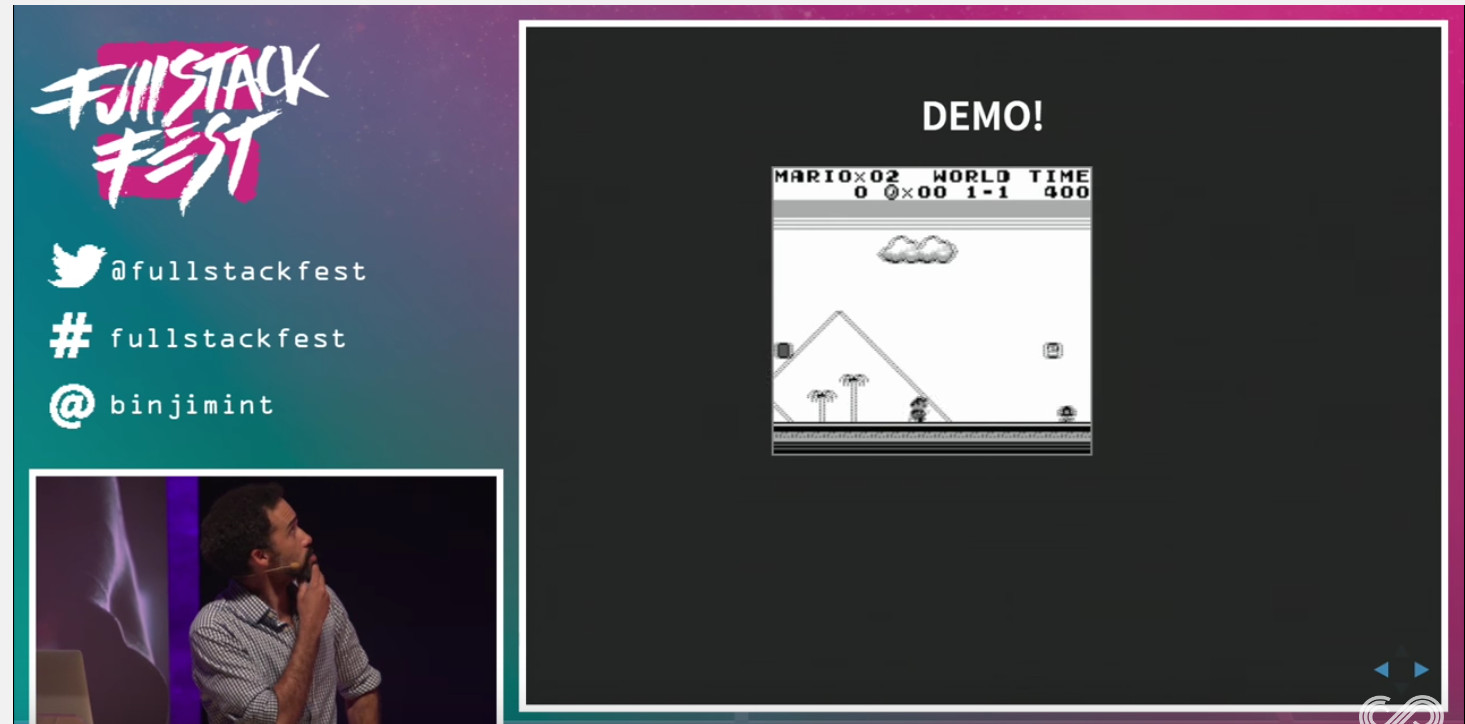binjgb on the web, part 2
This is part 2 of a series on binjgb, see part 1!
WebAssembly

For the past few years I've been contributing to the WebAssembly project. I primarily have been working on wabt, a suite of tools for working with WebAssembly files. It's been a lot of fun, and I've learned a lot too. And there's a lot I could write about WebAssembly, and I probably will at some point. But for now, the only reason I brought it up is because it leads to...
FullStackFest
Last year, I was invited to give a talk at FullStackFest about WebAssembly, titled "WebAssembly: birth of a virtual ISA". The talk is basically an overview of WebAssembly, followed by a deep dive where I take C++, convert it to the WebAssembly text format, then convert that to the WebAssembly binary format, then finally convert it to x86 assembly, all in 30 minutes!
I wanted a nice WebAssembly demo for the talk. There's the AngryBots demo on the WebAssembly homepage, which is pretty cool, but I wanted something that was more me. I had started working on binjgb earlier that year, so it seemed like an obvious choice. It's not very flashy, and sure, there are tons of Gameboy emulators around, but I was proud of my little creation and I wanted to show it off!
Since the talk was about WebAssembly, I needed to get a WebAssembly version building, so I started hacking away on it during the week of the conference. Without too much effort, I ended up with the code you saw in part 1. Since my slides were made using reveal.js, I was easily able to embed the running emulator into my slides as an iframe:

Probably should have spent some time centering the iframe... oh, well. I really wanted to get audio working, so you could hear that dee-da-da-dum, bee--bum, but I just didn't have the time. I actually didn't even get it working until earlier this month.
WebAudio
I'd never used WebAudio before, and it's a bit tricky to know exactly how you're supposed to use it. If you are just trying to play a wav or mp3, it's pretty easy and straightforward. But what if you're trying to programatically generate audio?
Most sources point to the ScriptProcessorNode for this.
Here's the basic idea:
// Create your audio context.
var ctx = new AudioContext();
// Create a node w/ buffer size 4096 and one output channel.
var node = new ScriptProcessorNode(4096, 0, 1);
node.onaudioprocess = function(event) {
var buffer = event.outputBuffer;
var channel = buffer.getChannelData(0);
for (var i = 0; i < 4096; ++i) {
// Write samples, f32 in range [-1, 1].
channel[i] = ...;
}
}
// Wire the node up to the AudioContext sink.
node.connect(ctx.destination);This does work. But it has a couple problems. First it's callback based. That would be fine if the callback could interrupt your running code. But it can't, so if you're hogging the main JavaScript thread, then your audio buffer isn't being filled.
The next problem is that it is deprecated, and has been since August 29th, 2014, if MDN is to be believed.
Better than ScriptProcessorNode
MDN says that ScriptProcessorNode is deprecated. OK, so what do we use instead?
... and is soon to be replaced by Audio Workers.
OK, sounds good. So how do you use Audio Workers?
Audio workers ... are not implemented in any browsers yet.
(-_-)
So I went to see what Emscripten does. Rather than having the audio engine pull samples via a callback, they push buffers down and tell the engine to play them at a specific time. Something like this:
var buffer = ctx.createBuffer(channels, samples, sampleRate);
var channel = buffer.getChannelData(0);
for (var i = 0; i < 4096; ++i) {
channel[i] = ...;
}
var bufferSource = ctx.createBufferSource();
bufferSource.buffer = buffer;
bufferSource.connect(ctx.destination);
bufferSource.start(playTime);This works surprisingly well! Since we're pushing the data down, we can do it
at any time, including during our requestAnimationFrame callback. We don't
have to worry about yielding control of the main thread to allow an audio
callback to fire.
To get gapless playback, you just need to make sure that you have the next
buffer queued up before the current buffer finishes playing. You can determine
how long this buffer will play by calculating samples / sampleRate. So the
next buffer should start playing at playTime + samples / sampleRate.
The audio engine has a builtin timer (accessed via ctx.currentTime) that you
can use to schedule the playback. The first buffer should start playing a
little after the current time. The further out you push it, the more time you
have to queue up the subsequent buffers.
Speaking of which, here are a few issues that you may run into when implementing audio playback...
Audio Caveats
If you're playing audio and you drop a buffer (i.e. you don't queue up a buffer quickly enough for the audio engine), you'll immediately hear it as a pop, click or crackle. It sounds horrible.
The only way to resolve this is to introduce latency -- increase the buffer size or push out the time between now and when the next buffer plays. Increasing the latency means you're less likely to starve the audio engine, but also means that the audio and input will be desynchronized: you press the jump button and hear the jump half a second later.
Implementing WebAudio in binjgb
I finally had a pretty decent implementation using the above strategy in binjgb. You can take a look at the commit here. One interesting aspect is that binjgb generates a 2-channel, interleaved 8-bit audio stream. Since WebAudio requires a 32-bit float audio stream, with indpendent channels, we have to move things around a bit:
var channel0 = buffer.getChannelData(0);
var channel1 = buffer.getChannelData(1);
var outPos = 0;
var inPos = 0;
for (var i = 0; i < inSamples; i++) {
channel0[outPos] = (audioBuffer[inPos] - 128) / 128;
channel1[outPos] = (audioBuffer[inPos+1] - 128) / 128;
outPos++;
inPos += 2;
}This audio implementation is still pretty much what I have now. There's still more to talk about, though. In my next post, we'll dive into WebGL!
In the meantime, I'll leave you with this, some of my favorite videogame music:
